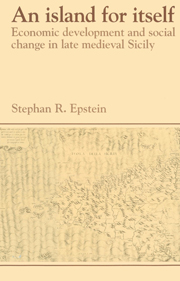Book contents
- Frontmatter
- Contents
- List of maps
- List of tables
- Acknowledgments
- Abbreviations
- Currency and measurements
- Chronology
- 1 Introduction. The historiography and the sources
- 2 Regional geographic and demographic differentiation
- 3 Market structures and regional specialization
- 4 Sicily and its regions. Economic growth and specialization
- 5 Sicily and its regions. Eastern val Demone and the southern mainland
- 6 Foreign trade and the domestic economy
- 7 Income distribution, social conflict and the Sicilian state
- 8 A further question: the origins of Sicilian underdevelopment
- Bibliography
- Index
- Past and Present Publications
3 - Market structures and regional specialization
Published online by Cambridge University Press: 06 January 2010
- Frontmatter
- Contents
- List of maps
- List of tables
- Acknowledgments
- Abbreviations
- Currency and measurements
- Chronology
- 1 Introduction. The historiography and the sources
- 2 Regional geographic and demographic differentiation
- 3 Market structures and regional specialization
- 4 Sicily and its regions. Economic growth and specialization
- 5 Sicily and its regions. Eastern val Demone and the southern mainland
- 6 Foreign trade and the domestic economy
- 7 Income distribution, social conflict and the Sicilian state
- 8 A further question: the origins of Sicilian underdevelopment
- Bibliography
- Index
- Past and Present Publications
Summary
I argue in this book that the late medieval economic crisis in western Europe promoted regional integration and specialization. In the final part of chapter 2, I briefly discussed the effect of some late medieval institutional changes on the distribution of the Sicilian population, on the assumption that the latter reflected fairly accurately how regional institutions distributed resources. In so doing, I was viewing the population as a body of consumers. In order to examine the hypothesis of increasing regional specialization, however, it is necessary to view the economy as a collectivity of producers. I suggested at the outset of chapter 2 that producers responded to changes in late medieval society by taking increasing advantage of the environmental and demographic resources at their disposal; the purpose of that chapter was to examine the patterning of those resources. The extent to which comparative advantages could be exploited, however, depended to a considerable degree on the nature of the markets which producers had access to. The structure of these markets, hence the nature of the institutional opportunities for specialization through trade, is the problem I analyse below. In this and the next two chapters, I discuss market integration and specialization within Sicily itself; I examine specialization between Sicily and other regions in chapter 6.
- Type
- Chapter
- Information
- An Island for ItselfEconomic Development and Social Change in Late Medieval Sicily, pp. 75 - 161Publisher: Cambridge University PressPrint publication year: 1992



